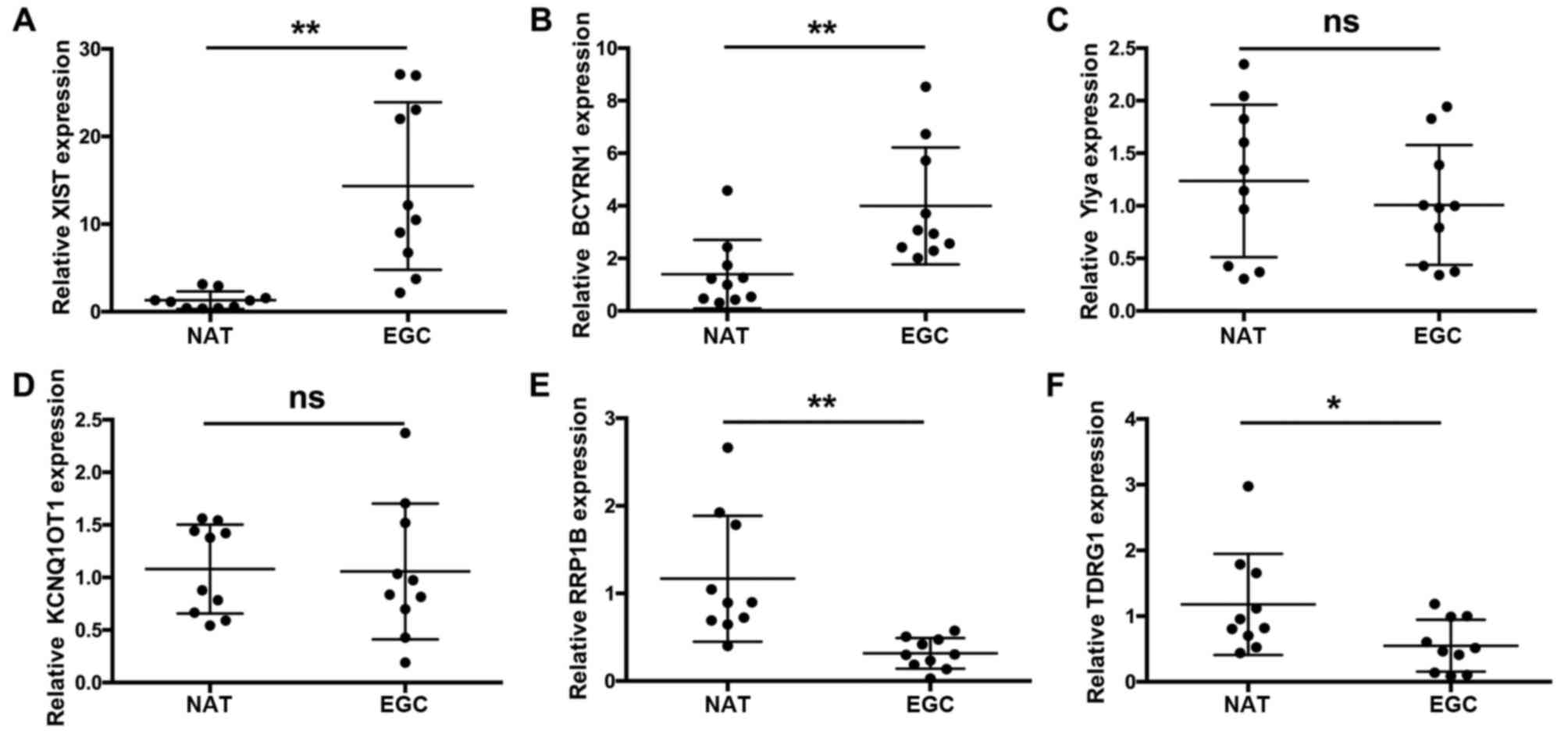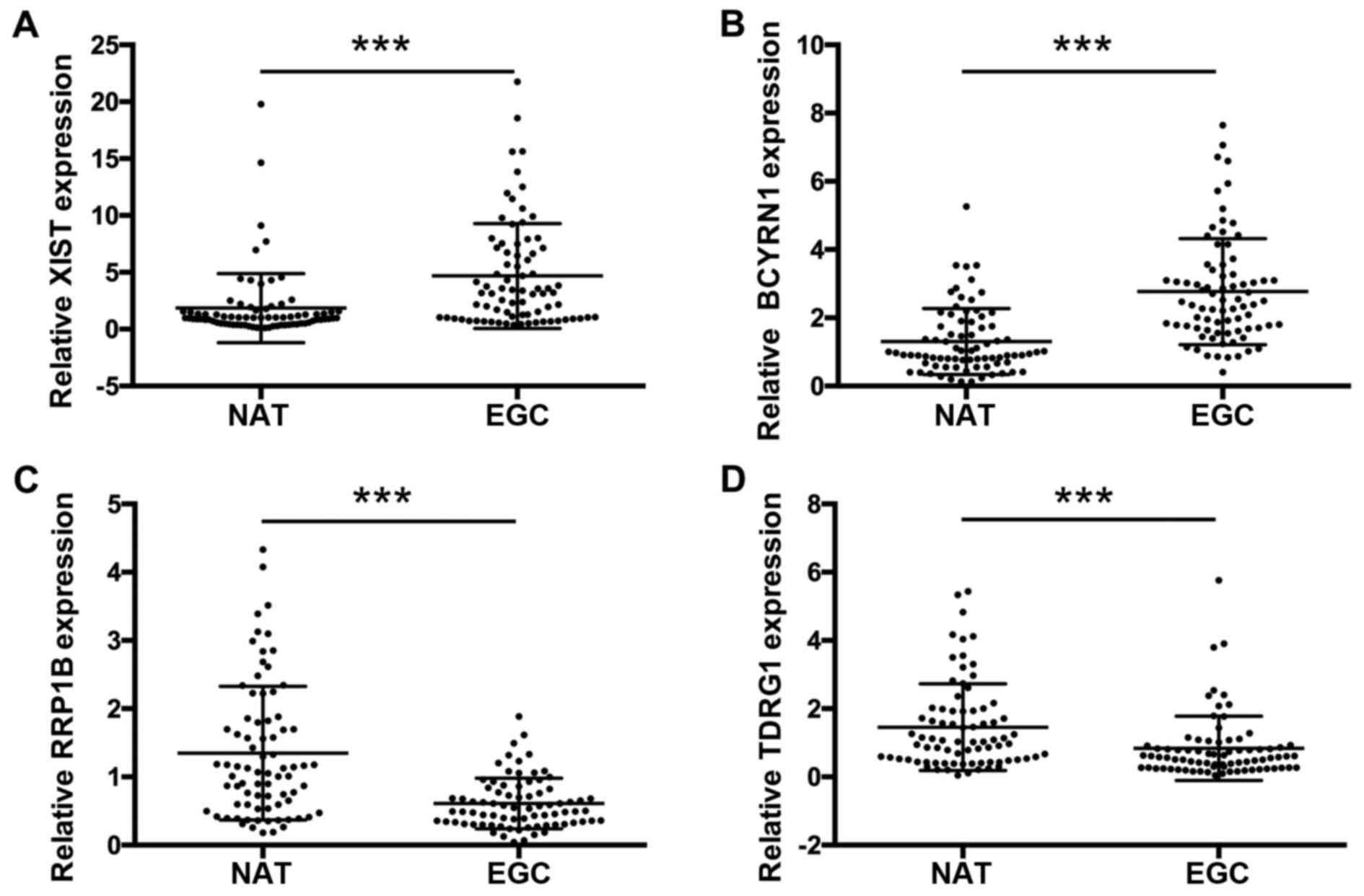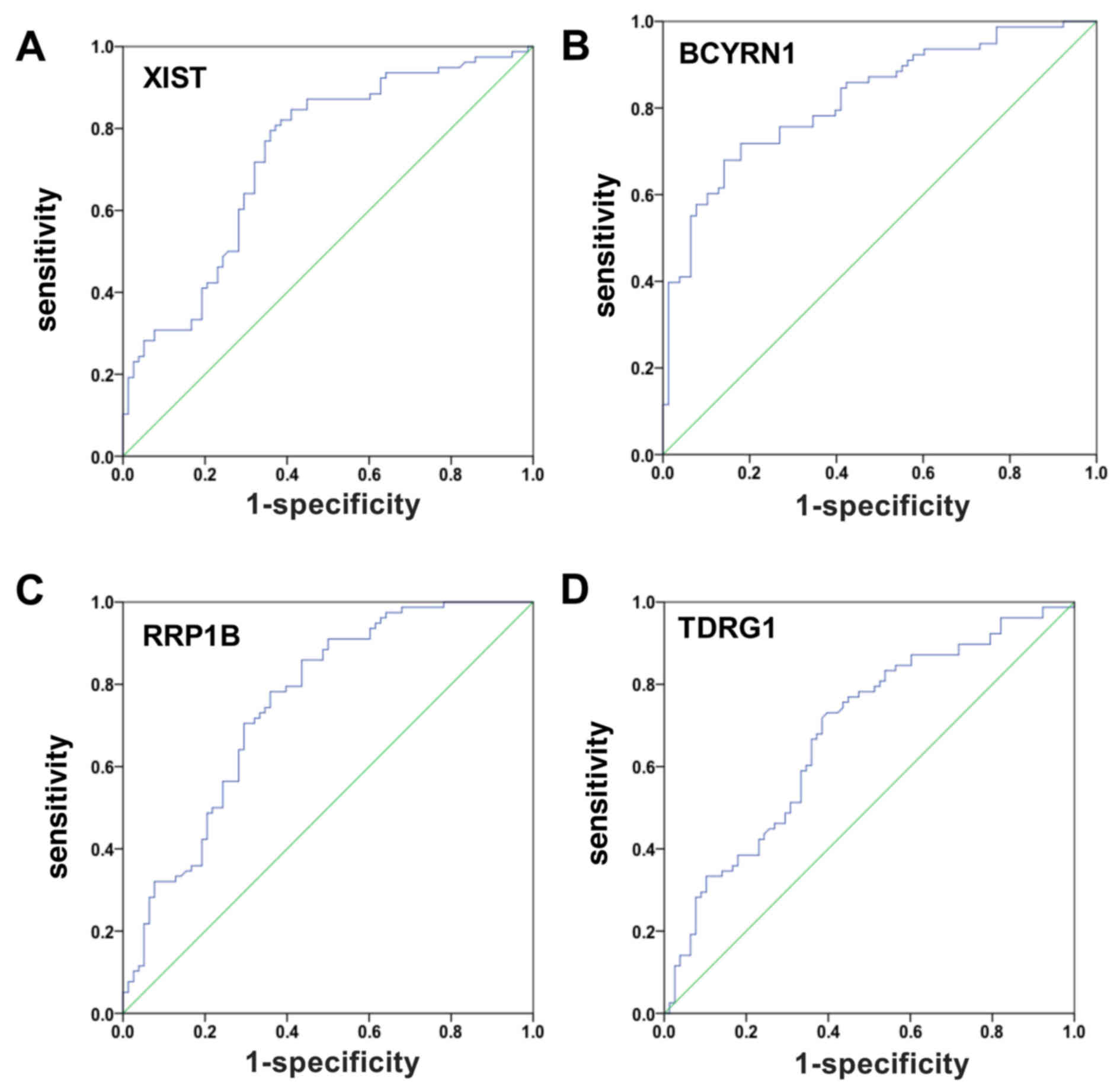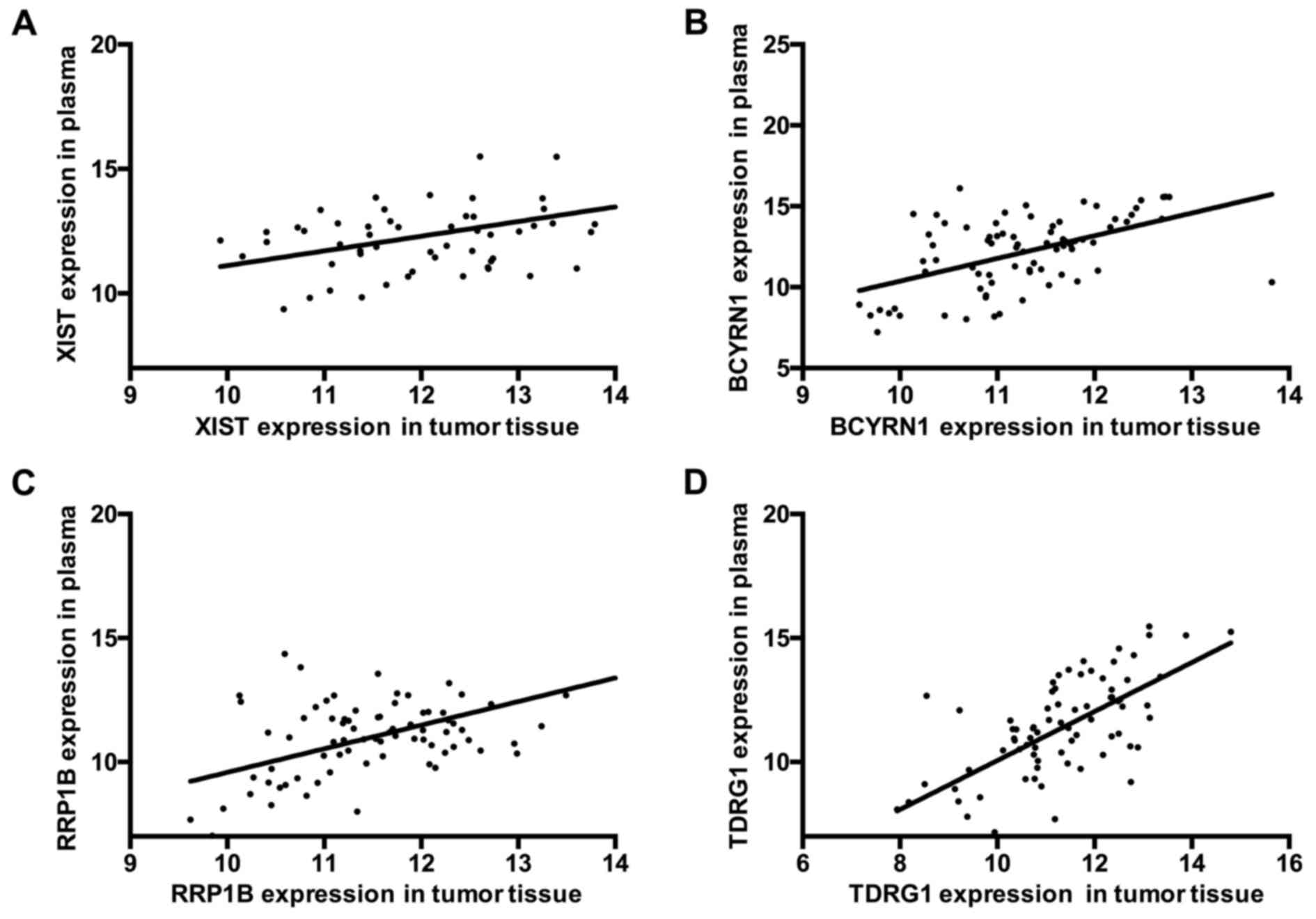Potential lncRNA diagnostic biomarkers for early gastric cancer
- Authors:
- Published online on: October 12, 2017 https://doi.org/10.3892/mmr.2017.7770
- Pages: 9545-9552
Abstract
Introduction
Gastric cancer (GC) is a high-incidence disease worldwide, particularly in Eastern Asia, although there has been a recent downward trend in morbidity (1); GC is the third major cause of cancer-related mortality in the world (2). Patients with early GC (EGC) may be cured completely though effective treatment. At present, although surgery, chemotherapy and radiotherapy are used in treatments, the prognosis of patients with GC is still very poor owing to metastasis (3–6). Therefore, early diagnosis serves an important role in reducing GC-related mortality. However, as there are no effective diagnostic signs or sensitive biomarkers for early diagnosis, most GC patients develop terminal cancer (7). Therefore, identifying specific biomarkers and effective molecular targets for GC are extremely important.
Long noncoding RNAs (lncRNAs) are a type of noncoding RNA that are >200 nucleotides, which regulate gene expression through transcription regulation, post-transcription regulation, chromatin modification and genomic imprinting (8,9). An increasing number of studies have indicated that lncRNAs participated in various biological processes, such as cell cycle and cell differentiation (10), apoptosis (11,12), epithelial-mesenchymal transition (EMT), cell migration and metastasis (13). Several previous studies have reported that lncRNAs may be closely associated with tumor genesis, including liver cancer (14), lung cancer (15), ovarian cancer (16), colorectal cancer (17) and breast cancer (18–20). Therefore, lncRNAs may be potential diagnostic biomarkers for certain diseases. A previous report using a human lncRNA microarray identified 33 differentially expressed lncRNAs associated with EGC, including 13 that were upregulated and 20 downregulated (21). The present study further validated that X inactive-specific transcript (XIST), brain cytoplasmic RNA 1 (BCYRN1), ribosomal RNA processing 1B (RRP1B) and testes development related 1 (TDRG1) were aberrantly expressed both in EGC tissues and plasma.
The present study examined the expression levels of XIST, Yiya, BCYRN1, RRP1B, KCNQ1 opposite transcript 1 (KCNQ1OT1) and TDRG1 in EGC tissues and normal adjacent tissues (NATs) by reverse transcription-quantitative polymerase chain reaction (RT-qPCR). XIST, BCYRN1, RRP1B and TDRG1 were identified as differentially expressed in EGC tissues compared with NATs, and exhibited potential diagnostic values for the detection of EGC. The expression level of RRP1B was significantly correlated with distal metastasis and tumor-node-metastasis (TNM) staging, and the expression of TDRG1 was significantly correlated with lymph node metastasis. Furthermore, significant positive correlations for XIST, BCYRN1, RRP1B and TDRG1 expression levels were made between the EGC tissues and plasma. Therefore, XIST, BCYRN1, RRP1B and TDRG1 may serve as potential diagnostic biomarkers for EGC.
Materials and methods
Clinical specimens
The present study was approved by the Ethics committee of Zhongda Hospital, School of Medicine, Southeast University (Nanjing, China), and informed consent was received from each patient. A total of 76 pairs of EGC tissues and paired NATs were collected from Zhongda Hospital between May 2014 and November 2016. Among them, 10 pairs of EGC tissues and paired NATs were used to preliminarily detect the XIST, Yiya, BCYRN1, RRP1B, KCNQ1OT1 and TDRG1 expression levels. The 10 patients included 5 males and 5 female patients, and the average age was 63.4 and 64.2 years old. None of the patients in the study received radiotherapy or chemotherapy prior to surgical resection. All collected tissue samples were frozen at −80°C for total RNA extraction. Peripheral blood (5 ml) was collected from the 76 fasting patients prior to endoscopy, and controls (76 healthy patients, including 32 males and 44 female patients, and the average age was 65.4 and 61.2 years old) were done at the same time; serum was separated by centrifugation (3,500 × g; 10 min; 10°C) and the serum supernatant was frozen at −80°C until further analysis.
RT-qPCR
Total RNA was extracted from EGC tissues (100 mg for every organization) and paired NATs using the RNeasy Plus Mini kit (Qiagen, Inc., Valencia, CA, USA) according to the manufacturer's protocol. Total RNA was extracted from serum (800 µl) using the QIAamp Circulating Nucleic Acid kit (QiagenKK, Tokyo, Japan). RNA purity was measured using the NanoDrop (Peqlab Biotechnologie GmbH, Erlangen, Germany). The OD260/280 ratio was used as indicator for RNA purity. A ratio higher than 1.8 was regarded as suitable for gene expression measurements. The RevertAid First Strand cDNA Synthesis kit (Thermo Fisher Scientific, Inc., Waltham, MA, USA) was used to synthesize cDNA according to the manufacturer's protocol. XIST, Yiya, BCYRN1, RRP1B, KCNQ1OT1 and TDRG1 expression were examined in EGC tissues (paired NATs were used as control) and EGC plasma (healthy patient serum were used as control) by RT-qPCR using the SYBRGreen Master Mix kit (Takara Bio, Inc., Otsu Japan) and PRISM 7900HT sequence detection system (Applied Biosystems; Thermo Fisher Scientific, Inc.) as described previously (22). The quantitative PCRs were carried out in 20-µl reaction volume containing 2 µl cDNA products. Reaction steps were as follows: 95°C for 30 sec (predegeneration) as the first step in a loop; 95°C for 5 sec (degeneration), 60°C for 34 sec (extension) as the second step, a total of 40 cycles. The data was analyzed using SDS 2.3 software (Applied Biosystems; Thermo Fisher Scientific, Inc.). The specificity of primer sequences was measured according to the dissociation curve, and the relative gene expression levels were analyzed using the 2−ΔΔCq (quantitation threshold) method (23). All data are presented as the mean ± standard deviation of three independent experiments. The following qPCR primers were used: XIST, forward 5′-AACCACCTACACTTGAGCCA-3′, reverse 5′-AGGACAATGACGAAGCCACT-3′; Yiya, forward 5′-TTGAGTCGGATCCTCTCAGC-3′, reverse 5′-CTCTCTGAGTTGCCCTTGGA-3′; BCYRN1, forward 5′-TCATGAAGCTTGCCTCTGGA-3′, reverse 5′-AACATGGAGAGGGAAGGTGG-3′; RRP1B, forward 5′-CACAGCACAAACACGAGTCA-3′, reverse 5′-TGCCTTCTACTTGGTGAGGG-3′; KCNQ1OT1, forward 5′-TGGTAAGTTACAGGGCAGGG-3′, reverse 5′-TGAACATCCATCCCCAAGCT-3′; TDRG1, forward 5′-GGTGCAGTCTTCAGGGATCT-3′, reverse 5′-GCCTCCCTCCTCTTCATTGT-3′; GAPDH, forward 5′-TGTTCGTCATGGGTGTGAAC-3′, reverse 5′-ATGGCATGGACTGTGGTCAT-3′. Samples were normalized to GAPDH.
Statistical analysis
All data and calculations were analyzed using Prism6 (GraphPad Software Inc., La Jolla, CA, USA) and SPSS 17.0 (SPSS, Inc., Chicago, IL, USA). The area under the receiver operating characteristic (ROC) curve (AUC) was used to assess the predictive power and to determine the cut-off scores for XIST, BCYRN1, RRP1B and TDRG1 expression levels between patients with EGC and controls. The differences in lncRNA expressions (XIST, BCYRN1, RRP1B and TDRG1) in tissues among the patients were analyzed using the χ2 test concerning clinical parameters such as age (>60 vs. <60 years), sex (male vs. female), pathological node (pN status; N0 vs. N1-N2), pathological metastasis (pM status; M0 vs. M1), and clinical stage (I and II vs. III and IV). For paracarcinoma-carcinoma paired tissues, the difference in lncRNA expression was evaluated using paired Student's t-test. The relationship of lncRNA expression in EGC tissue and plasma was analyzed using Mantel-Haenszel statistics. All results are presented as the mean ± standard deviation (SD). P<0.05 was considered to indicate a statistically significant difference.
Results
XIST, Yiya, BCYRN1, RRP1B, KCNQ1OT1 and TDRG1 expression levels in EGC tissues and NATs
A previous study analyzed lncRNA expression profiles including XIST, Yiya, BCYRN1, RRP1B, KCNQ1OT1 and TDRG1 in GC tissues and paired NATs by a human lncRNA microarray (21). This previous study identified 68 lncRNAs that were associated with diseases, of which the top 33 were demonstrated to be differentially expressed, including 13 upregulated and 20 downregulated lncRNAs. As hypoxia inducible factor 1α-antisense RNA 1 (HIF1α-AS1), plasmacytoma variant translocation 1 (PVT1), carbonyl reductase 3-antisense RNA 1 (CBR3-AS1) and urothelial cancer associated 1 (UCA1) have been identified previously, the present study further examined the expression levels of XIST, Yiya, BCYRN1, RRP1B, KCNQ1OT1 and TDRG1 by RT-qPCR in EGC tissues and NATs (21). Initially, we identified six abnormally expressed lncRNAs in 10 tissues as a preliminary screening. The results demonstrate that the expression levels of XIST (Fig. 1A) and BCYRN1 (Fig. 1B) were significantly increased in EGC tissues compared with NATs (n=10; **P<0.01); Yiya (Fig. 1C) and KCNQ1OT1 (Fig. 1D) exhibited no significant changes in expression levels in EGC tissues compared with NATs (n=10); and the expression levels of RRP1B (Fig. 1E) and TDRG1 (Fig. 1F) were significantly decreased in EGC tissues compared with NATs (n=10; *P<0.05 and **P<0.01, respectively).
XIST, BCYRN1, RRP1B and TDRG1 expression levels were validated in EGC tissues and NATs
In the preliminary study described above, XIST, BCYRN1, RRP1B and TDRG1 were differentially expressed in EGC tissues (n=10) compared with NATs (n=10), while Yiya and KCNQ1OT1 expressions exhibited no significant alterations in EGC tissues compared with NATs. Therefore, we further collected the EGC tissues and paired NATs from 76 patients. The expression levels of XIST, BCYRN1, RRP1B and TDRG1 were measured by RT-qPCR. The results demonstrated that the expression levels of XIST (Fig. 2A) and BCYRN1 (Fig. 2B) were significantly increased in EGC tissues compared with NATs (n=76; ***P<0.001). In addition, the expression levels of RRP1B (Fig. 2C) and TDRG1 (Fig. 2D) were significantly decreased in EGC tissues compared with NATs (n=76; ***P<0.001). Therefore, XIST, BCYRN1, RRP1B and TDRG1may serve as potential candidates as biomarkers for EGC.
In addition, no significant correlations were identified between the expression levels of XIST or BCYRN1 and clinicopathological characteristics (Tables I and II, respectively). Conversely, the expression level of RRP1B was significantly correlated with pathological metastasis (pM) and clinical stage (Table III), and the expression level of TDRG1 was significantly correlated with pathological node (pN) (Table IV).
Table I.Associations between XIST expression level and clinicopathological characteristics in 76 patients. |
Table II.Associations between BCYRN expression level and clinicopathological characteristics in 76 patients. |
Table III.Associations between RRP1B expression level and clinicopathological characteristics in 76 patients. |
Table IV.Associations between TDRG1 expression level and clinicopathological characteristics in 76 patients. |
XIST, BCYRN1, RRP1B and TDRG1 may be used as noninvasive biomarkers for EGC
The ROC curve is a comprehensive index that reflects the sensitivity and specificity of continuous variables. In the present study, the occurrence of EGC was predicted by ROC curve analysis using XIST, BCYRN1, RRP1B and TDRG1 expressions in 76 EGC samples and paired NATs (controls). The AUC for XIST was 0.733 (sensitivity=0.846; specificity=0.590; ***P<0.001; Fig. 3A). The AUC for BCYRN1 was 0.821 (sensitivity=0.679; specificity=0.859; ***P<0.001; Fig. 3B). The AUC for RRP1B was 0.753 (sensitivity=0.859; specificity=0.564; ***P<0.001; Fig. 3C). The AUC for TDRG1 was 0.681 (sensitivity=0.731; specificity=0.603; ***P<0.001; Fig. 3D). These data suggested that XIST, BCYRN1, RRP1B and TDRG1 may be able to serve as biomarkers of EGC.
Positive correlation of XIST, BCYRN1, RRP1B and TDRG1 expression between EGC tissue and plasma
Similar to EGC tissues, the expression levels of XIST and BCYRN1 were increased and the expression levels of RRP1B and TDRG1 were decreased in the plasma from patients with EGC. The correlations for XIST, BCYRN1, RRP1B and TDRG1 expression levels between EGC tissue and plasma were further analyzed and the results indicated that there was a positive correlation for XIST expression between EGC tissues and plasma (R2=0.2650; ***P<0.001; Fig. 4A). A positive correlation was also made between EGC tissues and plasma for BCYRN1 expression (R2=0.2686; ***P<0.001; Fig. 4B), RRP1B expression (R2=0.2920; ***P<0.001; Fig. 4C), and TDRG1 expression (R2=0.4120; ***P<0.001; Fig. 4D). These results demonstrated that XIST, BCYRN1, RRP1B and TDRG1 were aberrantly expressed both in EGC tissues and plasma, which may be related to EGC disease progression.
Discussion
Currently, the study of biomarkers study has focused on noncoding RNAs, particularly lncRNAs, most of which are transcribed by RNA polymerase (Pol) II and Pol I, but some are transcribed by RNA Pol III (24). A number of previous studies have indicated that lncRNAs serve important roles in regulating gene expression (20,25–27) and participate in cell cycle and differentiation (10), apoptosis (11,12) and chromatin remodeling (28–30). Other studies have demonstrated that lncRNAs were involved in the development of various cancers (31). For example, long intergenic noncoding RNA for kinase activation (LINK-A) was reported to activate normoxic HIF1α signaling in certain breast cancers (32); antisense noncoding RNA in the INK4 locus (ANRIL) may be a potential prognostic biomarker in GC and has been demonstrated to regulate microRNA (miR)-99a/miR-449a (33); and lncRNA-n336928 has been correlated with bladder cancer tumor stage and overall survival (34). Therefore, lncRNAs may be important regulatory factors for gene expressions, yet their functions in cancer remain unclear and requires a deeper understanding of the regulatory networks that may be involved.
A previous study identified 33 differentially expressed lncRNAs using a human lncRNA microarray to screen GC tissues and paired NATs (21). Other studies have reported that H19 promotes proliferation of GC cells and high expression of H19 indicates a poor prognosis in patients with GC (35,36); prostate cancer associated 3 (PCA3) is highly expressed in prostate cancer (37); HOX transcript antisense RNA (HOTAIR) promotes tumor invasion and reverses EMT in GC (38,39). In addition, a decrease in the expression of growth arrest specific 5 (GAS5) was revealed to induce a poor prognosis and accelerate cell proliferation in GC (40), and metastasis associate lung adenocarcinoma transcript 1 (MALAT1) was reported to enhance GC cell proliferation through pre-mRNA-splicing factor SF2/alternative splicing factor (ASF) (41). HIF1A-AS1, PVT1, CBR3-AS1 and UCA1 have also been identified in GC (21), and the present study examined the expression levels of XIST, Yiya, BCYRN1, RRP1B, KCNQ1OT1 and TDRG1 in EGC.
In the present study, it was demonstrated that XIST and BCYRN1 were significantly upregulated, and RRP1B and TDRG1 were significantly downregulated, in EGC tissues compared with NATs. RRP1B was correlated with pM and clinical stage, and TDRG1 was correlated with pN. In addition, there were positive correlations for XIST, BCYRN1, RRP1B and TDRG1 expressions between EGC tissue and plasma. Therefore, it was suggested that XIST, BCYRN1, RRP1B and TDRG1 may be promising candidates for the diagnosis of EGC.
In conclusion, RT-qPCR analysis demonstrated that XIST, BCYRN1, RRP1B and TDRG1 were differentially expressed in EGC tissues compared with NATs, and ROC curve analysis indicated that these lncRNAs have potential diagnostic values for the detection of EGC. Furthermore, the results indicated that there were significant positive correlations of XIST, BCYRN1, RRP1B and TDRG1 expression levels between the EGC tissues and plasmas. Therefore, the present study suggested that XIST, BCYRN1, RRP1B and TDRG1 may potentially serve as diagnostic biomarkers for EGC.
Acknowledgements
The present study was supported by the Jiangsu Provincial Traditional Chinese Medicine Bureau of Science and Technology Project (grant no. YB2015181).
References
|
Torre LA, Bray F, Siegel RL, Ferlay J, Lortet-Tieulent J and Jemal A: Global cancer statistics, 2012. CA Cancer J Clin. 65:87–108. 2015. View Article : Google Scholar : PubMed/NCBI | |
|
Lin M, Shi C, Lin X, Pan J, Shen S, Xu Z and Chen Q: sMicroRNA-1290 inhibits cells proliferation and migration by targeting FOXA1 in gastric cancer cells. Gene. 582:137–142. 2016. View Article : Google Scholar : PubMed/NCBI | |
|
Baĭramov RB and Abdullaeva RT: The impact of early gastric cancer diagnosis on indices of survival in patients after radical surgical intervention. Klin Khir. 1–21. 2013. | |
|
Bang CS, Baik GH, Shin IS, Kim JB, Suk KT, Yoon JH, Kim YS and Kim DJ: Helicobacter pylori Eradication for prevention of metachronous recurrence after endoscopic resection of early gastric cancer. J Korean Med Sci. 30:749–756. 2015. View Article : Google Scholar : PubMed/NCBI | |
|
Pasechnikov V, Chukov S, Fedorov E, Kikuste I and Leja M: Gastric cancer: Prevention, screening and early diagnosis. World J Gastroenterol. 20:13842–13862. 2014. View Article : Google Scholar : PubMed/NCBI | |
|
Waddell T, Verheij M, Allum W, Cunningham D, Cervantes A and Arnold D; European Society for Medical Oncology (ESMO), ; European Society of Surgical Oncology (ESSO), ; European Society of Radiotherapy and Oncology (ESTRO), : Gastric cancer: ESMO-ESSO-ESTRO clinical practice guidelines for diagnosis, treatment and follow-up. Eur J Surg Oncol. 40:584–591. 2014. View Article : Google Scholar : PubMed/NCBI | |
|
Cai H, Yuan Y, Hao YF, Guo TK, Wei X and Zhang YM: Plasma microRNAs serve as novel potential biomarkers for early detection of gastric cancer. Med Oncol. 30:4522013. View Article : Google Scholar : PubMed/NCBI | |
|
Guttman M and Rinn JL: Modular regulatory principles of large non-coding RNAs. Nature. 482:339–346. 2012. View Article : Google Scholar : PubMed/NCBI | |
|
Khalil AM, Guttman M, Huarte M, Garber M, Raj A, Morales D Rivea, Thomas K, Presser A, Bernstein BE, van Oudenaarden A, et al: Many human large intergenic noncoding RNAs associate with chromatin-modifying complexes and affect gene expression. Proc Natl Acad Sci USA. 106:pp. 11667–11672. 2009; View Article : Google Scholar : PubMed/NCBI | |
|
Liu X, Li D, Zhang W, Guo M and Zhan Q: Long non-coding RNA gadd7 interacts with TDP-43 and regulates Cdk6 mRNA decay. EMBO J. 31:4415–4427. 2012. View Article : Google Scholar : PubMed/NCBI | |
|
Lakhotia SC: Long non-coding RNAs coordinate cellular responses to stress. Wiley Interdiscip Rev RNA. 3:779–796. 2012. View Article : Google Scholar : PubMed/NCBI | |
|
Paralkar VR and Weiss MJ: A new ‘Linc’ between noncoding RNAs and blood development. Genes Dev. 25:2555–2558. 2011. View Article : Google Scholar : PubMed/NCBI | |
|
Dhamija S and Diederichs S: From junk to master regulators of invasion: lncRNA functions in migration, EMT and metastasis. Int J Cancer. 139:269–280. 2016. View Article : Google Scholar : PubMed/NCBI | |
|
Yang F, Zhang L, Huo XS, Yuan JH, Xu D, Yuan SX, Zhu N, Zhou WP, Yang GS, Wang YZ, et al: Long noncoding RNA high expression in hepatocellular carcinoma facilitates tumor growth through enhancer of zeste homolog 2 in humans. Hepatology. 54:1679–1689. 2011. View Article : Google Scholar : PubMed/NCBI | |
|
Enfield KS, Pikor LA, Martinez VD and Lam WL: Mechanistic roles of noncoding RNAs in lung cancer biology and their clinical implications. Genet Res Int. 2012:7374162012.PubMed/NCBI | |
|
Chai Y, Liu J, Zhang Z and Liu L: HuR-regulated lncRNA NEAT1 stability in tumorigenesis and progression of ovarian cancer. Cancer Med. 5:1588–1598. 2016. View Article : Google Scholar : PubMed/NCBI | |
|
Qi P, Dong L, Lin W, Zhou X and Du X: Abstract B42: A two-lncRNA signature in serous exosomes serves as a new biomarker for colorectal cancer diagnosis. Cancer Res. 76:B422016. View Article : Google Scholar | |
|
Piao HL and Ma L: Non-coding RNAs as regulators of mammary development and breast cancer. J Mammary Gland Biol Neoplasia. 17:33–42. 2012. View Article : Google Scholar : PubMed/NCBI | |
|
Zhao W, An Y, Liang Y and Xie XW: Role of HOTAIR long noncoding RNA in metastatic progression of lung cancer. Eur Rev Med Pharmacol Sci. 18:1930–1936. 2014.PubMed/NCBI | |
|
Mercer TR, Dinger ME and Mattick JS: Long non-coding RNAs: Insights into functions. Nat Rev Genet. 10:155–159. 2009. View Article : Google Scholar : PubMed/NCBI | |
|
Gao J, Cao R and Mu H: Long non-coding RNA UCA1 may be a novel diagnostic and predictive biomarker in plasma for early gastric cancer. Int J Clin Exp Pathol. 8:12936–12942. 2015.PubMed/NCBI | |
|
Jiang L, Lai YK, Zhang J, Wang H, Lin MC, He ML and Kung HF: Targeting S100P inhibits colon cancer growth and metastasis by Lentivirus-mediated RNA interference and proteomic analysis. Mol Med. 17:709–716. 2011. View Article : Google Scholar : PubMed/NCBI | |
|
Livak KJ and Schmittgen TD: Analysis of relative gene expression data using real-time quantitative PCR and the 2(-Delta Delta C(T)) method. Methods. 25:402–408. 2001. View Article : Google Scholar : PubMed/NCBI | |
|
Bierhoff H, Schmitz K, Maass F, Ye J and Grummt I: Noncoding transcripts in sense and antisense orientation regulate the epigenetic state of ribosomal RNA genes. Cold Spring Harb Symp Quant Biol. 75:357–364. 2010. View Article : Google Scholar : PubMed/NCBI | |
|
Wang KC and Chang HY: Molecular mechanisms of long noncoding RNAs. Mol Cell. 43:904–914. 2011. View Article : Google Scholar : PubMed/NCBI | |
|
Nagano T and Fraser P: No-nonsense functions for long noncoding RNAs. Cell. 145:178–181. 2011. View Article : Google Scholar : PubMed/NCBI | |
|
Loewer S, Cabili MN, Guttman M, Loh YH, Thomas K, Park IH, Garber M, Curran M, Onder T, Agarwal S, et al: Large intergenic non-coding RNA-RoR modulates reprogramming of human induced pluripotent stem cells. Nat Genet. 42:1113–1117. 2010. View Article : Google Scholar : PubMed/NCBI | |
|
Saxena A and Carninci P: Long non-coding RNA modifies chromatin: Epigenetic silencing by long non-coding RNAs. Bioessays. 33:830–839. 2011. View Article : Google Scholar : PubMed/NCBI | |
|
Kotake Y, Nakagawa T, Kitagawa K, Suzuki S, Liu N, Kitagawa M and Xiong Y: Long non-coding RNA ANRIL is required for the PRC2 recruitment to and silencing of p15(INK4B) tumor suppressor gene. Oncogene. 30:1956–1962. 2011. View Article : Google Scholar : PubMed/NCBI | |
|
Tsai MC, Manor O, Wan Y, Mosammaparast N, Wang JK, Lan F, Shi Y, Segal E and Chang HY: Long noncoding RNA as modular scaffold of histone modification complexes. Science. 329:689–693. 2010. View Article : Google Scholar : PubMed/NCBI | |
|
Noori-Daloii MR and Eshaghkhani Y: lncRNAs roles in cancer occurrence. Med Sci J Islamic Azad Univesity-Tehran Medical Branch. 25:163–182. 2015. | |
|
Lin A, Li C, Xing Z, Hu Q, Liang K, Han L, Wang C, Hawke DH, Wang S, Zhang Y, et al: The LINK-A lncRNA activates normoxic HIF1 α signalling in triple-negative breast cancer. Nat Cell Biol. 18:213–224. 2016. View Article : Google Scholar : PubMed/NCBI | |
|
Xu Z, Chen J, Luk JM and De W: Abstract 157: LncRNA ANRIL indicates a potential prognostic biomarker in gastric cancer and promotes tumor growth by silencing of miR-99a/miR-449a. Cancer Res. 75:1572015. View Article : Google Scholar | |
|
Chen T, Xie W, Xie L, Sun Y, Zhang Y, Shen Z, Sha N, Xu H, Wu Z, Hu H and Wu C: Expression of long noncoding RNA lncRNA-n336928 is correlated with tumor stage and grade and overall survival in bladder cancer. Biochem Biophys Res Commun. 468:666–670. 2015. View Article : Google Scholar : PubMed/NCBI | |
|
Zhang G, Hou X, Li Y and Zhao M: MiR-205 inhibits cell apoptosis by targeting phosphatase and tensin homolog deleted on chromosome ten in endometrial cancer Ishikawa cells. BMC cancer. 14:4402014. View Article : Google Scholar : PubMed/NCBI | |
|
Yang F, Bi J, Xue X, Zheng L, Zhi K, Hua J and Fang G: Up-regulated long non-coding RNA H19 contributes to proliferation of gastric cancer cells. FEBS J. 279:3159–3165. 2012. View Article : Google Scholar : PubMed/NCBI | |
|
Yarmishyn AA and Kurochkin IV: Long noncoding RNAs: A potential novel class of cancer biomarkers. Front Genet. 6:1452015. View Article : Google Scholar : PubMed/NCBI | |
|
Endo H, Shiroki T, Nakagawa T, Yokoyama M, Tamai K, Yamanami H, Fujiya T, Sato I, Yamaguchi K, Tanaka N, et al: Enhanced expression of long non-coding RNA HOTAIR is associated with the development of gastric cancer. PLoS One. 8:e770702013. View Article : Google Scholar : PubMed/NCBI | |
|
Xu ZY, Yu QM, Du YA, Yang LT, Dong RZ, Huang L, Yu PF and Cheng XD: Knockdown of long non-coding RNA HOTAIR suppresses tumor invasion and reverses epithelial-mesenchymal transition in gastric cancer. Int J Biol Sci. 9:587–597. 2013. View Article : Google Scholar : PubMed/NCBI | |
|
Sun M, Jin FY, Xia R, Kong R, Li JH, Xu TP, Liu YW, Zhang EB, Liu XH and De W: Decreased expression of long noncoding RNA GAS5 indicates a poor prognosis and promotes cell proliferation in gastric cancer. BMC Cancer. 14:3192014. View Article : Google Scholar : PubMed/NCBI | |
|
Wang J, Su L, Chen X, Li P, Cai Q, Yu B, Liu B, Wu W and Zhu Z: MALAT1 promotes cell proliferation in gastric cancer by recruiting SF2/ASF. Biomed Pharmacother. 68:557–564. 2014. View Article : Google Scholar : PubMed/NCBI |













